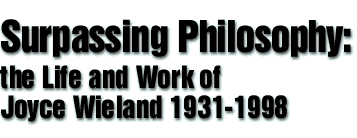|
 |
||
|
Helen de Witt pays tribute to the Canadian artist and avant garde filmmaker |
Joyce Wieland is best known for her filmmaking in New York in the 60s, but before arriving there from Toronto in 1963, she was already well known as a painter. Indeed, she was a controversial artist in Canada. Her paintings flaunted social convention through satire and graphic sexual imagery, which she used to express the particular experience of women; from oppression to desire.
As she developed her work, autobiographical themes were to become important to her and remained so throughout her career. Some commentators point to the fact that Joyce was orphaned aged just nine as an explanation for her continuous investigation of her personal memories and experiences in her work. Wieland's father was a British Music Hall performer who deserted his first wife and children when he met a sixteen year old runaway girl in London and immediately became besotted with her. To avoid controversy and to seek their fortune, they left for Canada after their first two children were born. Unfortunately, the young Joyce's father was not a success in Canada and he died in 1938. Her mother's death followed quickly in 1940.
After a series of odd jobs, Wieland decided to study art at the Toronto Central Technical High School from 1946 to 1949. When she left she worked first for an advertising company and then for Graphics Animation, an animated film company composed of young artists and former National Film Board of Canada filmmakers. She was not really a success at either company.
In 1956 Wieland married Michael Snow, then Canada's most promising young painter. Wieland and Snow played a major supporting role in each other's careers. Like other women artists married to famous artists, such as Lee Krasner (Jackson Pollock) and Elaine De Kooning (Willem De Kooning), her career was always in danger of being overshadowed by her famous husband. Ironically it was Snow who suggested that they move to the more prestigious art environment of New York and it was here Joyce, initially frightened by the congested urban environment and competitive art world, established herself as a successful artist in her own right. Wieland and Snow became regulars at Jonas Mekas' Showcase screenings and at Ken Jacob's weekly sessions in his loft under the Brooklyn Bridge. It was also at this time that Joyce began to make her first Super8 home movies.
Between 1965 and 1968 Wieland's films drew on issues of concern to the structural filmmakers of that time. 1933 (1967) is composed of monochromatically tinted loops of the street below her window over which the numbers 1933 are superimposed, on and off. Repetitious and interspersed white leader disrupt visual, spatial and narrative continuities. Similarly, Sailboat (1967) is a film of repetitive waterscapes in which a boat attempts to glide along the horizon and the word ‘sailboat' is superimposed on the screen.
Joyce Wieland's best known structural film is Rat Life and Diet in North America (1968)...
Full article published in Filmwaves - Issue 7, Spring 1999. Subscribe now!
